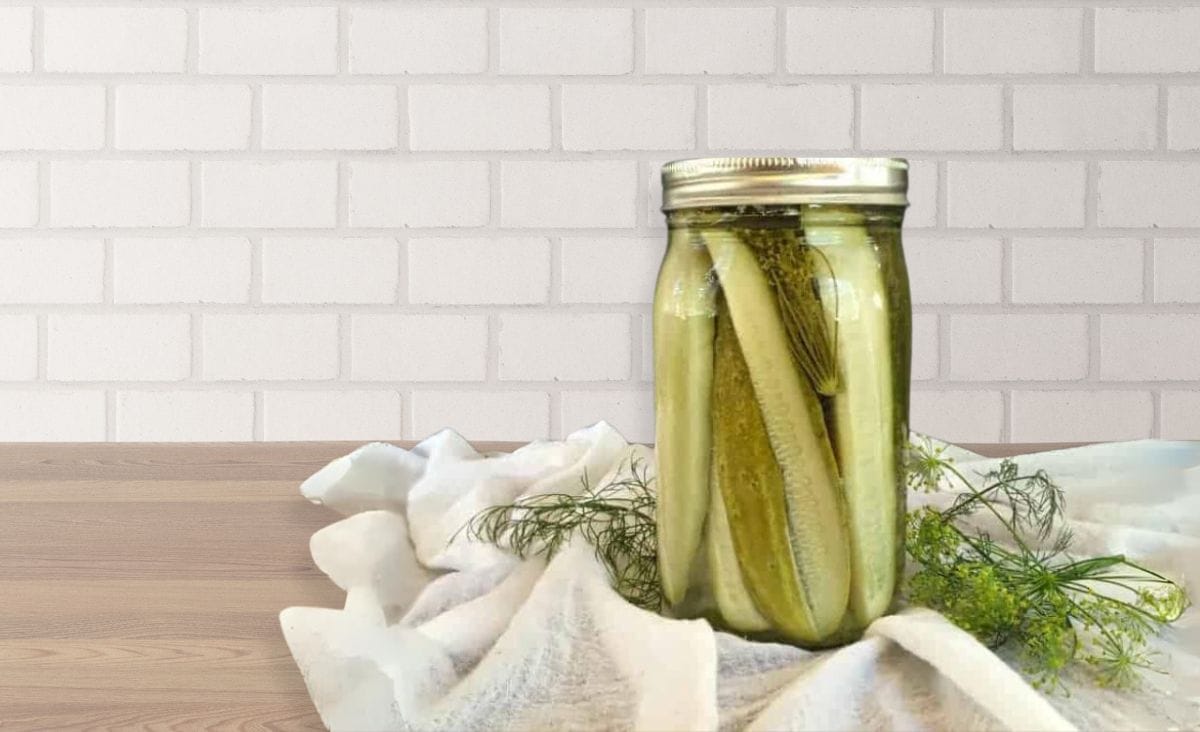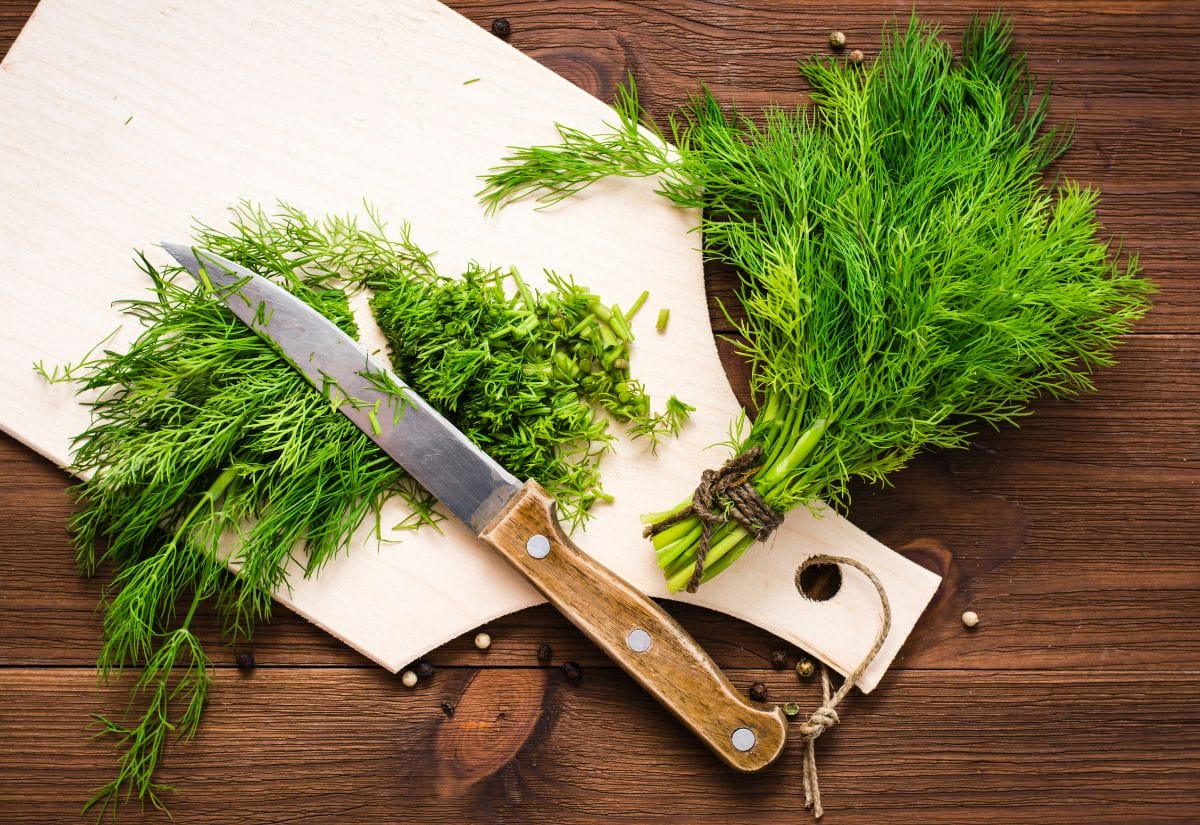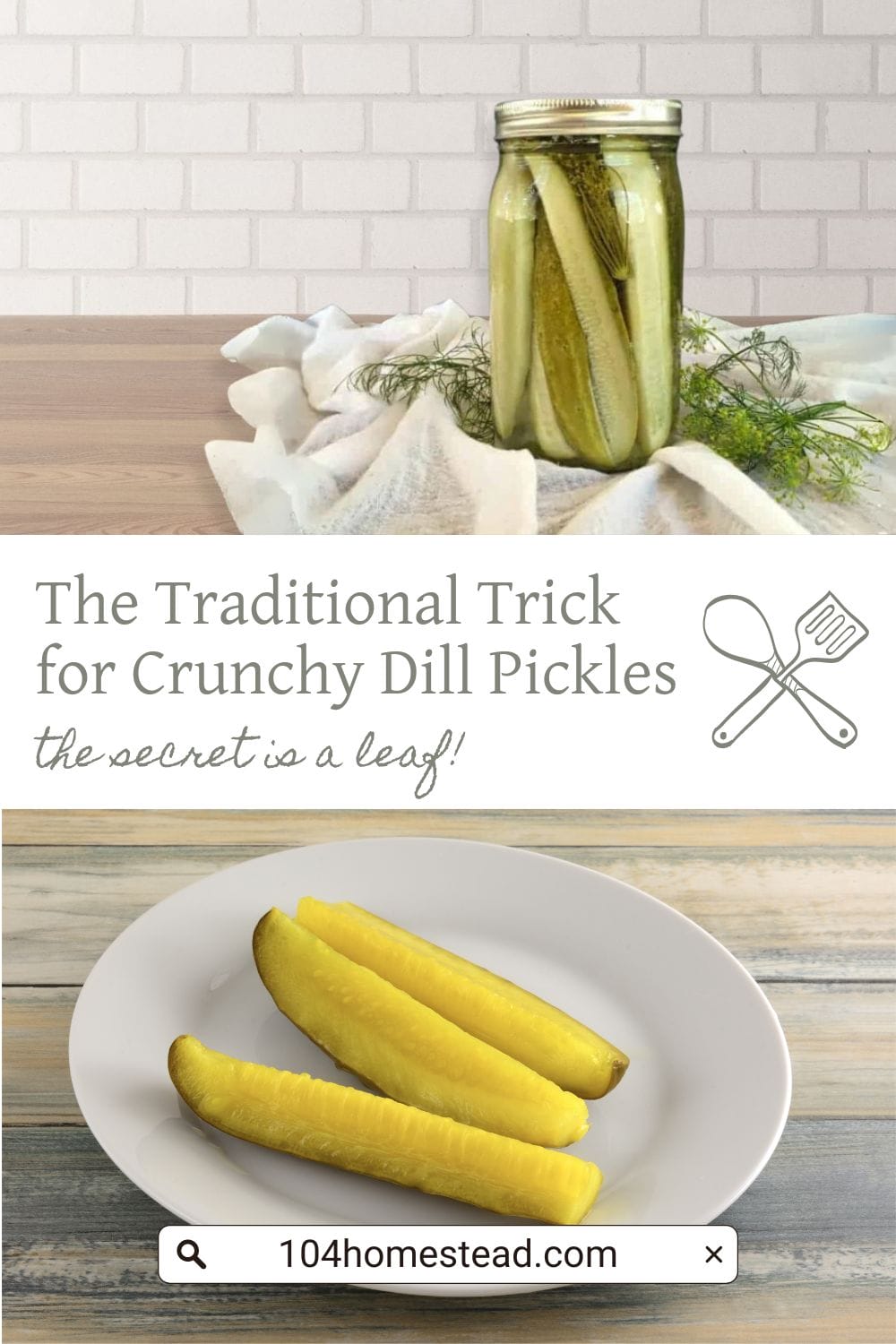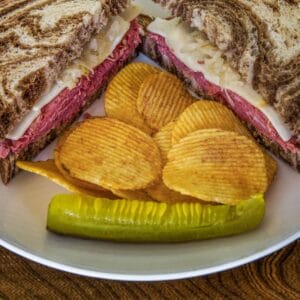The Secret Trick for Delicious and Crispy Dill Pickles
There are a lot of dill pickle recipe ideas online, but there is something they all lack. A single surprise ingredient for crispy pickles.

I love dill pickle spears. I prefer spears over coins because they stay crisper. Yes, late at night, I sneak to the kitchen to eat them right out of the jar. Shhh, don’t tell my children. The secret to a crispy pickle… leaves. Plant leaves.
Specifically, I am referring to grape leaves. Grape leaves contain tannins that inhibit a naturally occurring enzyme in cucumbers that causes them to soften. Other types of leaves (such as oak and cherry) work, but may cause a bitter taste in your pickles.
My Naturally Crispy Dill Pickle Recipe
Enjoy the timeless appeal of making your own dill pickles with this classic recipe. The crunchy, flavorful snack is made with the right amount of tangy vinegar, fragrant dill, and spices.
Ingredients for 6 Quarts of Pickles
This dill pickle recipe will make approximately 6 quarts of pickles if cut into spears. Less if cut into coins.
- 6 lbs. Cucumbers (see variety suggestions below)
- 3 c. White Vinegar
- 3 c. Water
- 6 tbsp. Dill Seeds
- 6 tbsp. Pickling Spice (see my recipe below)
- 2 tbsp. Kosher Salt
- 24 fresh Dill Sprigs
- 6 fresh Grape Leaves (washed and dried)
Step-by-Step Instructions
In a large saucepan over medium-high heat, combine the vinegar and salt. Add 3 cups of water and bring to a boil, stirring to dissolve the salt.
Meanwhile, in each jar, place 1 tablespoon of the pickling spices, 1 tablespoon of the dill seeds, 1 grape leaf, and 4 sprigs of dill. Put the cucumber spears in the jars upright, packing them tightly and avoiding large gaps. Ladle the salted vinegar water into the jars. If you are planning to keep them in the fridge, your work is done.
Allow them to rest for two weeks so the flavor can develop, and then sit back and enjoy. If you are canning, read on for processing instructions.
My Pickling Spice Recipe
This blend is perfect for all kinds of pickles, not just this dill pickle recipe. Double or triple it so you have plenty on hand for the harvest season.
- 2 tbsp. Black Peppercorns
- 2 tbsp. Mustard Seed
- 2 tbsp. Coriander
- 2 tbsp. Dill Seed
- 1 1/2 tbsp. Red Pepper Flakes
- 1 tbsp. Allspice
- 10 Bay Leaves

Additional Tricks for a Crispy Dill Pickle
Choosing the Right Cucumbers
Use the correct kind of cucumber. Persian and Kirby’s cucumbers stay crisper and firmer than English cucumbers.
Preparing Your Cucumbers Correctly
Use your cucumbers right after picking them. If they wilt even the slightest bit, your pickles may be compromised.
Be sure to cut off the blossom end of the cucumber which contains enzymes that soften your pickles. Speaking of cutting, the smaller your pieces, the softer they will become. It’s best to choose a small cucumber and divide it into large spears.
Let your cucumbers chill in an ice bath for four to five hours before starting to process them.
Processing Your Cucumbers Properly
Refrigerator (not canned) pickles, of course, stay firm because the canning process cooks them a bit. Refrigerator pickles are good for about 2 months. If you want to store your pickles for longer, canning is the best option. Just make sure you are watching the timer when you water bath them, so you are only cooking them as long as necessary for safe storage.
If you choose to water bath can your pickles, process them with a 1/2″ head space in quart jars for 15 minutes. I prefer name-brand Ball jars. In fact, it’s the only time I splurge on name-brands for just about anything, but I’ve found that in this case, it’s worth it. They are less prone to breakage than others on the market. Consider it an investment.
If you’re new to canning, I highly recommend grabbing a copy of Ball’s Book of Canning and Preserving. Not only is it chock full of recipes, but it also gives important information about safe canning practices. Also, be sure to check out my Water Bath Canning FAQs & Recipe Roundup.
Why I Don’t Use Crisping Agents
A note on Pickle Crisping Agents, I have heard positive reviews for it, but I’m leery of using it. These crisping agents are made of calcium chloride, which has been known to cause stomach pain, nausea, and vomiting. You can read more about its dangers at LiveStrong. The nice thing about this dill pickle recipe is that you’ll probably find they are crisp enough without additives.
Frequently Asked Questions
If you want to learn more about canning and get more recipes, check out my complete guide on water bath canning recipes and tips for new canners. Whether you are new to canning or just want to brush up on your skills, this guide is full of useful information that will help you along the way.
If you’ve found value in this blog post and enjoyed reading it, why not share it with your Pinterest community? Pin the image below and spread the love!

As you start to make these naturally crispy dill pickles, keep in mind that fun and creative recipes are the best ones. Take advantage of how easy it is to use grape leaves, and watch as your pickles turn into crunchy treats that will make everyone sneak into the kitchen to try.
How do you incorporate homemade pickles into your meals? I’m looking for new ideas and would love to hear your favorite pairings!

Classic Crunch Dill Pickles
This post may contain paid links. If you make a purchase using the links in this recipe, I may earn a commission.
Equipment
- 6 Mason Jars quart
Ingredients
- 6 lbs. Cucumbers recommend Persian or Kirby’s for best results
- 3 cups White Vinegar
- 3 cups Water
- 6 tbsp Dill Seeds
- 6 tbsp Homemade Pickling Spice
- 2 tbsp Kosher Salt
- 24 Dill Sprigs fresh sprigs
- 6 Grape Leaves fresh, cleaned and dried
Instructions
- Begin by combining the vinegar, water, and kosher salt in a large saucepan. Heat over medium-high until the mixture boils and the salt is fully dissolved.3 cups White Vinegar, 3 cups Water, 2 tbsp Kosher Salt
- In each sterilized jar, layer the bottom with a grape leaf, then add 1 tablespoon each of pickling spices and dill seeds, followed by 4 sprigs of dill.6 tbsp Dill Seeds, 6 tbsp Homemade Pickling Spice, 6 Grape Leaves, 24 Dill Sprigs
- Tightly pack the cucumber spears into the jars, ensuring minimal gaps.6 lbs. Cucumbers
- Pour the hot vinegar mixture over the cucumbers, filling each jar to just below the rim.
- Seal the jars. If refrigerating, let them sit for two weeks to develop flavor. For canning, follow the water bath method for 15 minutes with a 1/2″ headspace.
Notes
- Choosing the Right Cucumbers: Persian and Kirby’s cucumbers are ideal for their firm texture.
- Preparation Tips: Use cucumbers immediately after picking, and chill in an ice bath for 4-5 hours before pickling.
- Proper Processing: For refrigerator pickles, enjoy within 2 months. For longer storage, canning is your best bet, using quality jars like Ball for reliability.

